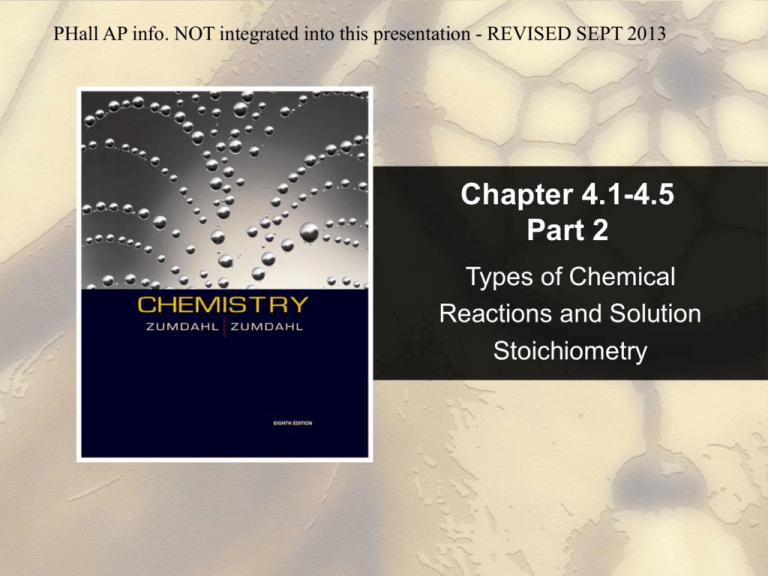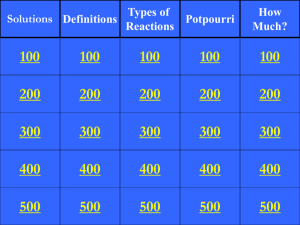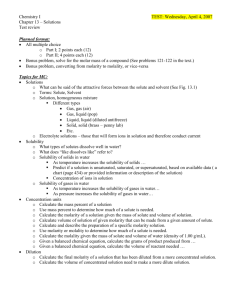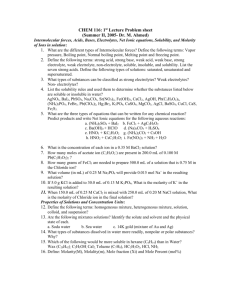
PHall AP info. NOT integrated into this presentation - REVISED SEPT 2013
Chapter 4.1-4.5
Part 2
Types of Chemical
Reactions and Solution
Stoichiometry
Chapter 4
Table of Contents
4.1
4.2
4.3
4.4
4.5
Water, the Common Solvent
The Nature of Aqueous Solutions: Strong and Weak
Electrolytes
The Composition of Solutions
Types of Chemical Reactions
Precipitation Reactions
Copyright © Cengage Learning. All rights reserved
2
Section 4.2
Electrolytes
The Nature of Aqueous Solutions: Strong and Weak Electrolytes
Strong Electrolytes – conduct current very efficiently (bulb shines
brightly). ex. ionic compounds (NaCl), strong acids (HCl, sulfuric,
nitric, and strong bases (KOH, NaOH)
Pull up solid sodium chloride video from podcast page to watch.
Return to TOC
Copyright © Cengage Learning. All rights reserved
6
Section 4.2
Electrolytes
The Nature of Aqueous Solutions: Strong and Weak Electrolytes
•
•
•
•
Weak Electrolytes – conduct only a small current (bulb
glows dimly).
weak acids (organic acids -acetic, citric, butyric, malic,
and weak basis (ammonia)
Nonelectrolytes – no current flows (bulb remains unlit).
ex. no ions present - sugars, alcohols &
ex. molecular compounds that are not acids
Return to TOC
Copyright © Cengage Learning. All rights reserved
6
Electrolytes
must be logged into textbook for this
one - you should still be logged in if you
did it with the first animation
Copyright © Houghton Mifflin Company. All rights reserved.
4–
Electrolyte Behavior
Click below to watch visualization.
http://college.cengage.com/chemistry/zumdahl/chemistry/7e
/assets/students/protected/fae/index.html?layer=act&src=qti
workflowflash_4_20.xml&w=750&h=434
Copyright © Houghton Mifflin Company. All rights reserved.
4–
Definition of Electrolytes and Nonelectrolytes
An electrolyte is:
A substance whose aqueous solution
conducts an electric current.
ex.ionic compounds & acids & bases
A nonelectrolyte is:
A substance whose aqueous solution does
not conduct an electric current.
ex. molecular compounds other than acids
and bases
Electrolytes vs. Nonelectrolytes
The ammeter measures the flow of electrons (current)
through the circuit.
If the ammeter measures a current, and the bulb
glows, then the solution conducts.
If the ammeter fails to measure a current, and the
bulb does not glow, the solution is non-conducting.
Try to classify the following substances as
electrolytes or nonelectrolytes…
1.Pure water
2.Tap water
• Sugar solution
• Sodium chloride solution
• Hydrochloric acid solution
• Lactic acid solution
• Ethyl alcohol solution
• Pure sodium chloride
Answers to Electrolytes
ELECTROLYTES:
NONELECTROLYTES:
Tap water (weak)
Pure water
NaCl solution
Sugar solution
• HCl solution
• Lactate solution (weak)
• Ethanol solution
• Pure NaCl
Pull up sugar videoclip
from podcast page to watch.
Ionic Compounds “Dissociate”
Na+(aq) + Cl-(aq)
NaCl(s)
+(aq) + NO -(aq)
Ag
AgNO3(s)
3
Mg2+(aq) + 2 Cl-(aq)
MgCl2(s)
2 Na+(aq) + SO42-(aq)
Na2SO4(s)
AlCl3(s)
Al3+(aq) + 3 Cl-(aq)
When ionic compounds dissociate completing, they are good electrolytes for
conducting electricity.
solution where they can
conduct a current rather
than re-forming a
The reason for this is the
solid.
polar nature of
the water molecule…
Positive ions associate with the negative
end of the water dipole (oxygen).
Negative ions associate with the positive
end of the water dipole (hydrogen).
Some covalent compounds IONIZE in solution
Covalent acids form ions in solution, with the
help of the water molecules.
For instance, hydrogen chloride molecules,
which are polar, give up their hydrogens to
water, forming chloride ions (Cl-) and
hydronium ions (H3O+).
Strong acids such as HCl are completely
ionized (or dissociated) in solution.
Other examples of strong acids include:
Sulfuric acid, H2SO4
Nitric acid, HNO3
Hydriodic acid, HI
Perchloric acid, HClO4
These would be examples of strong electrolytes.
Weak acids such as lactic
acid usually ionize less than
5% of the time.
Many of these weaker acids
are “organic” acids that contain
a “carboxyl” group.
The carboxyl group does not easily give up its
hydrogen.
Because of the carboxyl group, organic acids
are sometimes called “carboxylic acids”.
Other organic acids and their sources include:
o
o
o
o
o
o
Citric acid – citrus fruit
Malic acid – apples
Butyric acid – rancid butter
Amino acids – protein
Nucleic acids – DNA and RNA
Ascorbic acid – Vitamin C
This is an enormous group of compounds;
these are only a few examples.
Extra Information related to terms
Solution- a homogeneous mixture
of the solute and the solvent
Solution= solvent + solute
Aqueous (aq)= water solution
Tincture = alcohol solution
Amalgam= Mercury solution
17
S
o
l
u
t
i
o
n
s
solutionsxt
Solution Concentration
Section 4.3
The Composition of Solutions
Chemical Reactions of Solutions
•
We must know:
The nature of the reaction.
The amounts of chemicals present in
the solutions.
Return to TOC
Copyright © Cengage Learning. All rights reserved
8
Notes 4.3
Calculations of Solution Concentration:
Molarity
Molarity is the ratio of moles of
solute to liters of solution
The molarity definition is based on the volume of the solution, NOT
the volume of water.
Vocab. Lesson
Incorrect = The solution is 5.0 Molarity.
Correct= The solution is 5.0 Molar.
Section 4.3
The Composition of Solutions
Molarity
•
Molarity (M) = moles of solute per
volume of solution in liters:
Return to TOC
Copyright © Cengage Learning. All rights reserved
9
Section 4.3
The Composition of Solutions
Exercise A
A 500.0-g sample of potassium phosphate
is dissolved in enough water to make 1.50 L
of solution. What is the molarity of the
solution? (calculate #moles per L to get molarity)
Return to TOC
Copyright © Cengage Learning. All rights reserved
10
Section 4.3
The Composition of Solutions
Exercise A
A 500.0-g sample of potassium phosphate is
dissolved in enough water to make 1.50 L of
solution. What is the molarity of the solution?
(calculate #moles per L to get molarity)
K3PO4 is the formula and molar mass 212.27 g/mol
(500 g / 212.27 g/mol) / 1.5 L
Did you get the following ANSWER? with 3 sig. digits
1.57 M
Return to TOC
Copyright © Cengage Learning. All rights reserved
10
Preparation of Molar Solutions
Exercise B: How many grams of sodium chloride are
needed to prepare 1.50 liters of 0.500 M NaCl solution?
Step #1: Ask “How Much?” (What volume to prepare?)
Step #2: Ask “How Strong?” (What molarity?)
Step #3: Ask “What does it weigh?” (Molar mass is?)
Preparation of Molar Solutions
Exercise B: How many grams of sodium chloride are
needed to prepare 1.50 liters of 0.500 M NaCl solution?
Step #1: Ask “How Much?” (What volume to prepare?)
Step #2: Ask “How Strong?” (What molarity?)
Step #3: Ask “What does it weigh?” (Molar mass is?)
ANSWER
1.500 L
How much?
0.500 mol
58.44 g
1 L
1 mol
x How strong?
x
What does it weigh?
= 43.8 g
Section 4.3
The Composition of Solutions
Concentration of Ions
Ionic compounds dissociate in solution, multiplying the molarity
by the number of ions present.
•
For a 0.25 M CaCl2 solution:
CaCl2 → Ca2+ + 2Cl–
Ca2+: 1 × 0.25 M = 0.25 M Ca2+
Cl–: 2 × 0.25 M = 0.50 M Cl–.
Note that there were 2 times as many ions of Cl- formed, so the molarity was
doubled due to having twice as many moles like in the titration lab with citric
acid which had 3 moles hydrogen ions produced for each mole of the base.
Return to TOC
Copyright © Cengage Learning. All rights reserved
11
Section 4.3
Additional Examples if you need them
The Composition of Solutions
•
Ion Concentration from Solution Concentration
Ionic compounds dissociate in solution, multiplying the molarity by the number of ions present
What is the Chloride Concentrations [Cl-] in the following solutions?
2.0M NaCl
since NaCl dissolves according to this reaction
NaCl => Na+ + Cl-
the NaCl to Cl- ratio is 1:1, therefore [Cl-]= 1 x 2.0M =2.0M
1.5M AlCl3
since AlCl3 dissolves according to this reaction
AlCl3 = > Al3+ + 3 Cl-
the AlCl3 to Cl- ratio is 1:3, therefore [Cl-] = 3 x 1.5M= 4.5M
2.0M CaCl2
since CaCl2 dissolves according to this reaction
CaCl2 = > Ca2+ + 2 Cl-
the CaCl2 to Cl- ratio is 1:2, therefore [Cl-]= 2 x 2.0 M= 4.0 M
Return to TOC
28
Section 4.3
The Composition of Solutions
Rearranging the Molarity formula
• Liters of solution x molarity = moles of solute
Return to TOC
29
Section 4.3
The Composition of Solutions
Concept Check 4.3a
Which of the following solutions contains
the greatest number of ions?
a)
b)
c)
d)
400.0 mL of 0.10 M NaCl.
300.0 mL of 0.10 M CaCl2.
200.0 mL of 0.10 M FeCl3.
800.0 mL of 0.10 M sucrose.
Return to TOC
Copyright © Cengage Learning. All rights reserved
12
Section 4.3
The Composition of Solutions
Concept Check 4.3a
Which of the following solutions contains
the greatest number of ions?
a)
b)
c)
d)
400 x .10 x 2 = 80 mmol
300 x .1 x 3 = 90 mmol
200 x .1 x 4 = 80 mmol
0 (stays as a molecule) =
most moles would correspond to mos
ions if dissociates in solution.
400.0 mL of 0.10 M NaCl.
300.0 mL of 0.10 M CaCl2.
200.0 mL of 0.10 M FeCl3.
800.0 mL of 0.10 M sucrose.
Return to TOC
Copyright © Cengage Learning. All rights reserved
12
Section 4.3
The Composition of Solutions
Let’s Think About It
•
Where are we going?
•
To find the solution that contains the greatest
number of moles of ions.
How do we get there?
Draw molecular level pictures showing each
solution. Think about relative numbers of ions.
How many moles of each ion are in each
solution?
Return to TOC
Copyright © Cengage Learning. All rights reserved
13
Section 4.3
The Composition of Solutions
Notice
•
The solution with the greatest number of
ions is not necessarily the one in which:
the volume of the solution is the
largest.
the formula unit has the greatest
number of ions.
Return to TOC
Copyright © Cengage Learning. All rights reserved
14
Section 4.3
The Composition of Solutions
Dilution
•
•
•
The process of adding water to a
concentrated or stock solution to achieve
the molarity desired for a particular
solution.
Dilution with water does not alter the
numbers of moles of solute present.
Moles of solute before dilution = moles
of solute after dilution
M1V1 = M2V2
Return to TOC
Copyright © Cengage Learning. All rights reserved
15
Section 4.3
The Composition of Solutions
Concept Check 4.3b
A 0.50 M solution of sodium chloride in an open
beaker sits on a lab bench. Which of the
following would decrease the concentration of
the salt solution?
Add water to the solution.
Pour some of the solution down the sink drain.
Add more sodium chloride to the solution.
Let the solution sit out in the open air for a
couple of days.
e) At least two of the above would decrease the
concentration of the salt solution.
a)
b)
c)
d)
Copyright © Cengage Learning. All rights reserved
Return to TOC
16
Dilution
Exercise C: What volume of stock (11.6 M)
hydrochloric acid is needed to prepare 250. mL
of 3.0 M HCl solution?
MstockVstock = MdiluteVdilute
(11.6 M)(Vstock L) = (3.0 M)(0.250 L)
Vstock Liters = (3.0 M)(0.250 Liters)
11.6 M
= 0.065 L
• Dilution
You try: Commercially available concentrated HCl is
usually a 12.0 M solution. How does one prepare 100.
mL of 1.0 M HCl solution from 12.0 M HCl solution?
ANSWER - DILUTION PROBLEM
•
Example: Commercially available concentrated HCl is usually
a 12.0 M solution. How does one prepare 100. mL of 1.0 M HCl
solution from 12.0 M HCl solution?
The obvious answer is to dilute the HCl solution. But, what volume
of 12.0 M HCl should be diluted? Recall the definition of molarity.
Moles of solute (n) = Molarity (M) x liters of solution (L)
This equation can be written as: moles of solute (n) = Mi x Vi . The
subscript “i” stands for “initial”.
www.t2i2edu.com
ANSWER - DILUTION PROBLEM
•
Now, add water to the stock solution. This
changes the concentration from Mi to Mf and
the volume from Vi to Vf. The subscript “f”
stands for “final”.
•
Because the number of moles of solute has
not changed during dilution, moles of solute
(n) = Mf x Vf, and, Mi x Vi = Mf x Vf
www.t2i2edu.com
ANSWER - DILUTION PROBLEM
•
Mi = 12.0 M
•
Vi = To be calculated
•
Mf = 1.0 M
•
Vf = 100. mL
•
12.0 M x Vi = 1.0 M x 100. mL
•
8.3 mL of HCl should be put into a 100mL volumetric flask and
filled with water to create a 1.0M solution.
www.t2i2edu.com
Section 4.3
The Composition of Solutions
• Qualitatively, a dilute solution has a low concentration
of solute.
AND
*A concentrated solution has a high concentration of
solute.
Return to TOC
41
Serial Dilution is a multiple dilution
which could follow the steps several
times. Other methods exists but will
not be required on this unit test but
may have to be done in college
chemistry.
How to Make a Dilution
This is an optional video for lab and calculating dilutions - Use if needed.
For PC - copy this link:
http://www.youtube.com/watch?v=MG86IFZi_XM#t=53
Click or copy the link below to go to video online
http://www.youtube.com/watch?v=MG86IFZi_XM#t=53
I had to delete embedded file due to size.
This will only work with MAC as it’s an embedded file
Copyright © Houghton Mifflin Company. All rights reserved.
4–
Dilution
Click here to watch video This requires log-in to
textbook
Copyright © Houghton Mifflin Company. All rights reserved.
4–
Section 4.3
The Composition of Solutions
Exercise 4.3 D
What is the minimum volume of a 2.00 M
NaOH solution needed to make 150.0 mL of
a 0.800 M NaOH solution?
Return to TOC
Copyright © Cengage Learning. All rights reserved
17
Section 4.3
The Composition of Solutions
Exercise 4.3 D
What is the minimum volume of a 2.00 M
NaOH solution needed to make 150.0 mL of
a 0.800 M NaOH solution?
ANSWER: 60.0 mL
Return to TOC
Copyright © Cengage Learning. All rights reserved
17
Section 4.4
Types of Chemical Reactions
Return to TOC
Copyright © Cengage Learning. All rights reserved
18
Section 4.4
Types of Chemical Reactions
Classification Used in General Chemistry Last Year
These are the 3 major classifications our textbook will use or AP Chemistry.
•
•
•
Precipitation Reactions
Acid–Base Reactions
Oxidation–Reduction Reactions
Return to TOC
Copyright © Cengage Learning. All rights reserved
18
Precipitation Reactions
Graphic: Wikimedia Commons User Tubifex
Section 4.5
Precipitation Reactions
Precipitation Reaction
•
A double displacement reaction in
which a solid forms and separates from
the solution.
When ionic compounds dissolve in
water, the resulting solution contains
the separated ions.
Precipitate – the solid that forms.
Return to TOC
Copyright © Cengage Learning. All rights reserved
19
Section 4.5
Precipitation Reactions
The Reaction of K2CrO4(aq) and Ba(NO3)2(aq)
Ba(NO3)2 (aq) + K2CrO4(aq) → BaCrO4(s) + 2KNO3
•
•
net equation
Ba2+(aq) + CrO42–(aq) → BaCrO4(s)
Return to TOC
Copyright © Cengage Learning. All rights reserved
20
Precipitation of Silver Chloride
Click here to watch visualization
Copyright © Houghton Mifflin Company. All rights reserved.
4–
Double Replacement Reactions
The ions of two compounds exchange places
in an aqueous solution to form two new
compounds.
AX + BY AY + BX
One of the compounds formed is usually a
precipitate (an insoluble solid), an insoluble
gas that bubbles out of solution, or a
molecular compound, usually water.
Double replacement forming a precipitate…
Lead(II) nitrate + potassium iodide lead(II) iodide + potassium nitrate
Double replacement (ionic) equation
Pb(NO3)2(aq) + 2KI(aq) PbI2(s) + 2KNO3(aq)
Complete ionic equation shows compounds as aqueous ions
Pb2+(aq) + 2 NO3-(aq) + 2 K+(aq) +2 I-(aq) PbI2(s) + 2K+(aq) + 2 NO3-(aq)
Net ionic equation eliminates the spectator ions
Pb2+(aq) + 2 I-(aq) PbI2(s)
Solubility Rules – Mostly Soluble
Ion
Solubility
Exceptions
NO3-
Soluble
None
ClO4-
Soluble
None
Na+
Soluble
None
K+
Soluble
None
NH4+
Soluble
None
Cl-, I-
Soluble
Pb2+, Ag+, Hg22+
SO42-
Soluble
Ca2+, Ba2+, Sr2+, Pb2+, Ag+, Hg2+
Solubility Rules – Mostly Insoluble
Ion
Solubility
Exceptions
CO32-
Insoluble
Group IA and NH4+
PO43-
Insoluble
Group IA and NH4+
OH-
Insoluble
Group IA and Ca2+, Ba2+, Sr2+
S2-
Insoluble
Groups IA, IIA, and NH4+
Table 4.1 Simple Rules for the
Solubility of Salts in Water
Copyright © Houghton Mifflin Company. All rights reserved.
4–
Solubility Rules Mnemonic Device Video
QuickTime™ and a
decompressor
are needed to see this picture.
Copyright © Houghton Mifflin Company. All rights reserved.
4–
Solubility Rules Made Easy Mnemonic Device
Acronym: “CASH ‘N GIA” Except CBS HAPpy
Copyright © Houghton Mifflin Company. All rights reserved.
4–
Soluble Rules Continued
Copyright © Houghton Mifflin Company. All rights reserved.
4–
Solubility Rules textbook log-in required
Click here to watch video.
Copyright © Houghton Mifflin Company. All rights reserved.
4–
Solubility
Chart:
Common
salts
at 25C
S = Soluble
I = Insoluble
P = Partially
Soluble
X = Other
Section 4.5
Precipitation Reactions
Precipitates
•
•
•
Soluble – solid dissolves in solution; (aq)
is used in reaction.
Insoluble – solid does not dissolve in
solution; (s) is used in reaction.
Insoluble and slightly soluble are often
used interchangeably.
Return to TOC
Copyright © Cengage Learning. All rights reserved
22
Section 4.5
Precipitation Reactions
Simple Rules for Solubility
1. Most nitrate (NO3 ) salts are soluble.
2. Most alkali metal (group 1A) salts and NH4+ are soluble.
3. Most Cl , Br , and I salts are soluble (except Ag+, Pb2+,
Hg22+).
4. Most sulfate salts are soluble (except BaSO4, PbSO4,
Hg2SO4, CaSO4).
5. Most OH are only slightly soluble (NaOH, KOH are
soluble, Ba(OH)2, Ca(OH)2 are marginally soluble).
6. Most S2 , CO32 , CrO42 , PO43 - salts are only slightly
soluble, except for those containing the cations in Rule 2.
Return to TOC
Copyright © Cengage Learning. All rights reserved
23
Solubility Trends
The solubility of MOST solids increases with
temperature.
The rate at which solids dissolve increases
with increasing surface area of the solid.
The solubility of gases decreases with
increases in temperature.
The solubility of gases increases with the
pressure above the solution.
Therefore…
Solids tend to dissolve best when:
o Heated
o Stirred
o Ground into small particles
Gases tend to dissolve best when:
o The solution is cold
o Pressure is high
Solubility Chart
Section 4.5
Example for setting up precipitation problem
Precipitation Reactions
Return to TOC
68
Saturation of Solutions
A solution that contains the maximum amount of
solute that may be dissolved under existing
conditions is saturated.
A solution that contains less solute than a
saturated solution under existing conditions is
unsaturated.
A solution that contains more dissolved solute than
a saturated solution under the same conditions is
supersaturated.
Section 4.5
Precipitation Reactions
Concept Check
Which of the following ions form compounds
with Pb2+ that are generally soluble in water?
a)
b)
c)
d)
e)
S2–
Cl–
NO3–
SO42–
Na+
Return to TOC
Copyright © Cengage Learning. All rights reserved
24
Section 4.5
Predicting Precipitation Products Videoclip
Precipitation Reactions
4:12 minutes
Pull up the Predicting Precipitation Products Videoclip to watch.
Return to TOC
71
Gravimetric Analysis
•
•
•
•
Gravimetric analysis: a chemical analysis
method based on the measurement of
masses.
Can be used in combination with
precipitation reactions to determine the
amount of a species present in solution.
First isolate the precipitate by filtration and
drying and subsequently weigh it.
Using this mass and stoichiometry
relationships, we can determine the amount
www.t2i2edu.com
Chapter 4
Class Assignments - Tues Oct. 1, 2013 and next slide
Table of Contents
• Homework Ch. 4 part 1
• Sect.4.1-4.5+ pg. 171-173 #17ab,18a-d+, 21a-c, 23a-d, 26,
27, 30a, 31, 33, 36(a-h), 38(a-d), 40, 41b, 47, 49, & 53
• (36 parts) due Monday - October 7th. Keep in mind you will
have other assignments on Thursday also, so try to get as
much done now as you can.
• CW: Take your balanced equation w/sheet and enter into
sciencegeek.net AP Chem Review:
•
http://www.sciencegeek.net/Chemistry/taters/EquationBalancing.htm
•
Show me score above & complete the following quiz & show me scores.
•
http://www.sciencegeek.net/APchemistry/APtaters/ReactionIdentification.htm
73
Chapter 4
Current & Upcoming Assignments - TUES - OCT 1, 2013
Table of Contents
•
•
•
•
CW: Go over some previous problems.
Notes 4.1-4.5+ including videoclips
Check balanced eqn sheet on computer - show score
Quiz - Types of chemical rxns (based on last year
classifications)
• Homework Ch. 4 part 1
• Sect.4.1-4.5+ pg. 171-173 #17ab,18a-d+, 21a-c, 23a-d, 26, 27,
30a, 31, 33, 36(a-h), 38(a-d), 40, 41b, 47, 49, & 53
• (36 parts) due Monday - October 7th. Keep in mind you will have other
assignments on Thursday also, so try to get as much done now as you can.
•
•
•
•
HW: Lab report Mass vs. Mole Relationships due Thursday
HW: Study for ch. 3 quiz on Thursday
HW today due with limiting reactants w/sheet by end of block.
TEST ch.3-4 tentatively set for October 11th
74
Section 4.5
Precipitation Reactions
END OF SLIDES FOR SECTION 4.1-4.5
• END OF SLIDES FOR SECTION 4.1-4.5
Return to TOC
75







